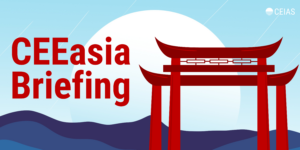Welcome to the 41st issue of the #CEEasia Briefing.
In this issue, we dissect the following topics:
- Relations between China and Hungary
- South Korea’s support for Ukraine
- NATO to set up a liaison office in Japan
Do you need to know more about East Asia? Don’t hesitate to shoot us a message about custom analysis tailored to your needs.
1. Wang Yi and Szijjártó meet again
What’s going on? During his recent trip to Beijing, Hungarian Minister of Foreign Affairs Péter Szijjártó praised China’s “peace plan” for Ukraine. Besides holding talks with his counterpart Qin Gang, China’s top diplomat Wang Yi and the Minister of Commerce Wang Wentao, Szijjártó also found time to visit the China-CEEC Expo in Ningbo, showing his support for strengthening of economic ties between the two countries.
Going deeper… Szijjártó’s visit was predominantly economic in nature, as seen in the announcement of further Chinese investment into Hungary’s automotive industry. This is significant as cooperation in EVs (spearheaded by CATL’s €7 billion investment into a battery plant in Debrecen) is quickly becoming an earmark of Sino-Hungarian economic relations.
Nevertheless… The visit was also marked by the usual political rhetoric about the strong partnership between the two states, with Hungary portrayed as China’s true and, to some extent, last remaining ally in Europe.
This means… As most of the EU member states in Central Europe are reassessing their relations with China, Budapest is going in the opposite direction. Hungary is not the only country that is hesitant about the EU’s recent shift towards de-risking the bloc’s relations with China. But Orbán’s unwillingness to reorientate his country’s foreign policy away from Beijing and Moscow continues to set Hungary apart from most of CEE.
2. Seoul pledges to increase non-lethal aid to Ukraine
What’s going on? The encounter between South Korean President Yoon Suk Yeol and Ukrainian President Zelensky in Hiroshima during the G7 summit in May, highlights South Korea’s commitment to providing non-lethal assistance to Ukraine. President Yoon pledged to support Ukraine diplomatically, economically, and through humanitarian aid (particularly via medical evacuation and demining vehicles). He also expressed Korea’s willingness to participate in post-war reconstruction projects.
Going deeper… President Zelensky held numerous meetings with other Asian leaders, including Indonesian President Joko Widodo and Japanese Prime Minister Fumio Kishida. This, together with the participation of South Korea (and other non-member countries like Australia, India and Vietnam) reflects the recognition of the global impact of the conflict and the need for broad international cooperation. Furthermore, the choice of Hiroshima held a symbolic reminder of the importance of peace, reconciliation, and the prevention of further conflicts in light of the city’s historical devastation.
What’s more… The willingness to provide more nonlethal military aid to the Eastern European nation resulted from an earlier meeting between South Korean President Yoon Suk Yeol and Ukraine’s first lady Olena Zelenska. In both cases, President Yoon actively supported close cooperation with NATO member states to aid Ukraine and stressed the importance of adhering to international rules condemning attempts to change the status quo by force, pointing to violations in Ukraine and North Korea.
3. NATO to set up a liaison office in Japan
What’s going on? NATO is planning to open its first Asian liaison office in Tokyo next year. And while this is to facilitate cooperation with Asian partners, the move might also further heighten existing tensions between Japan and China.
Going deeper… The office will allow NATO to conduct periodic consultations with Japan and other partners in the region such as South Korea, Australia and New Zealand. NATO and Japan are also supposed to upgrade their cooperation from Individual Partnership and Cooperation Programme (IPCP) to Individually Tailored Partnership Programme (ITPP), and expand collaboration in tackling cyber threats, disruptive technologies, and disinformation.
This means… The idea of opening a liaison office in Japan was reportedly first discussed in January, when NATO Secretary-General Jens Stoltenberg visited Japan and South Korea. The trip came after Japan’s Prime Minister Fumio Kishida, South Korean President Yoon Suk Yeol, Australian Prime Minister Anthony Albanese and then-New Zealand Prime Minister Jacinda Ardern (also called Asia-Pacific partners) attended the NATO Summit in Madrid last June. Indeed shortly after, South Korea created a dedicated diplomatic mission to NATO in Belgium. All four Asia-Pacific partners are also expected to attend the NATO Summit in Vilnius this July signaling NATO’s growing engagement with the region .
More broadly… Tensions between Japan and China have been rising in recent months amid joint Chinese-Russian naval patrols in the western Pacific near to Japan. Despite that, the Japanese Foreign Minister Yoshimasa Hayashi says the opening of the liaison office “is not intended…to be sending a message”. But this might not be how China perceives it. According to the Chinese Foreign Ministry “NATO’s continual eastward expansion…attempts to destroy regional peace and stability”. This raises a question of how China will respond and whether this could take a form of retaliatory steps in the form of boycotts as seen in the past.
Quick takes on CEEasia developments
CHINA & JAPAN | State Secretary of the Slovak Ministry of Foreign Affairs Ingrid Brocková held political consultations with her counterparts in China and Japan. While bilateral talks in Japan focused on providing humanitarian and economic help to Kyiv, in Beijing Brocková emphasized the importance of preserving peace and stability in the Taiwan Strait. This was Slovakia’s second high-level delegation to China in one month following the previous visit by the Speaker of Slovak Parliament Boris Kollár.
CHINA | The foreign ministers of Poland and Lithuania, meeting separately in Japan, discussed the impact of Russian aggression and the influence of China. All sides reaffirmed their commitment to fostering security and economic stability in Europe and the Indo-Pacific region and strengthening partnerships with like-minded nations.
TAIWAN | Europe is growing louder in its support for peace and stability across the Taiwan Strait. At the meeting of G7 foreign ministers in Japan and the Copenhagen Democracy Summit, European countries demonstrated their support for Taiwan’s inclusion in UN-affiliated bodies. This further shows that European support for Taiwan is gaining momentum, whilst expanding westwards from CEE to countries such as Belgium, France, Germany, Italy or Luxembourg.
INDIA | Delhi and Bucharest signed the first Defence Cooperation Pact in March to expand their bilateral cooperation into various other fields. In addition, the agreement is indicative of India’s growing strategic position, capacities, and importance in the global merit – even as Romania’s outspoken critique of Russia does not fully align with India’s fine balancing act.








